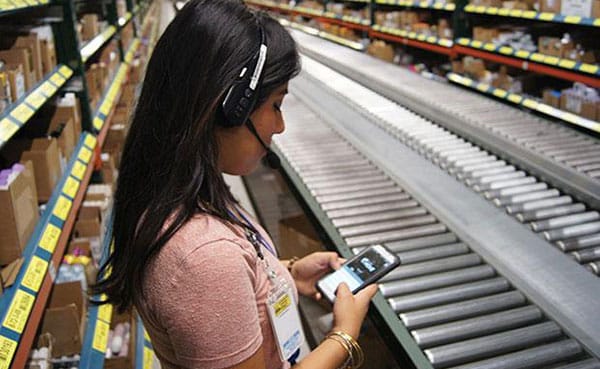Most people go to tradeshows to see the latest and greatest technology in action, so Lucas Systems always runs live voice-picking demos at big events like PROMAT and MODEX. Last month at MODEX 2014 we did something a little different: we ran two demos, and we held voice-picking races.
For the record, I completed the week with a perfect 3-0 record. However, we weren’t really so focused on the friendly competition among the pickers. That was really just a ploy to highlight a looming battle between industrial mobile computers typically used in a warehouse versus increasingly rugged smartphones that have started to enter the industrial workplace.
On one side of our booth, we had a basic case-picking demo running on mobile computers from Motorola and Datalogic. On the other side of the booth, we had a piece-picking demo running on a Samsung smartphone. The same Jennifer VoicePlus application was running on all of the devices, using the same Serenade speech recognition technology.
The Samsung device was connected wirelessly to a Bluetooth headset. Two of the three industrial devices had a wired headset, and we were also demonstrating a Motorola wearable with a Bluetooth headset. Two of the industrial devices had an integrated scanner, while the Motorola wearable and the Samsung phone can pair with a Bluetooth ring scanner. The point is, the applications running on the smartphone and the industrial devices were identical: they could all do scanning alongside voice, running the same user process flow. (To learn more about Jennifer for smartphones, read our press release announcing the new solution.)
Why Smartphones?
So why do we think smartphones are a good, viable platform for warehouse applications like Jennifer VoicePlus? First, smartphones have become more rugged and secure. In fact, with standard off-the-shelf cases, some smartphones have higher IP and drop protection ratings than industrial devices. Second, leading smartphones pack far more power in a far smaller package than anything offered by an industrial provider:
- They incorporate the latest, most powerful microprocessors;
- They come with tremendous amounts of fast, solid-state memory;
- They run the latest, most advanced mobile operating systems;
- They include support for the most current Wi-Fi and Bluetooth standards;
- They have beautiful screens and great visual user interfaces;
- They weigh less than a pound and fit in the palm of your hand.
An important additional advantage of the Samsung Galaxy, the first smartphone device we are certifying (and the best-selling smartphone in the world), is that there are hundreds of third-party companies developing accessories: hardened cases, charging stations, etc. Likewise, over the past 3-5 years enterprise-class mobile device management and security products have been introduced that address the security concerns that arose when the first wave of white-collar managers started using their own smartphones and tablets for work.
From Multi-Modal to Multi-Sensory
Beyond the higher “speeds and feeds,” the single greatest advantage of smartphone platforms is that they are part of an open ecosystem of mobile innovation that is resulting in new wearable devices like smartwatches and glasses that will open the floodgates to revolutionary new ways to work. With new forms of wearable devices, warehouse applications will go from multi-modal to multi-sensory. And this isn’t some far-off test-tube technology beyond the reach of everyday users. Smartwatches are commercially available today from leading manufacturers like Sony and Samsung.
In fact, as part of our smartphone demonstration at MODEX, we were also running a prototype of a smartwatch application that took an existing Jennifer feature – “show me” – and delivered it on a watch. Our standard Jennifer “show me” command allows users to ask to see product images or lists of items (or other information) which are then displayed on their mobile device screen. This feature is used by customers today running Jennifer on industrial devices. But using a smartphone-connected smartwatch we can push that visual information to a user’s wrist. Now, instead of unclipping the device to look at the screen, the user can just look at his smartwatch. That’s a better, more ergonomic solution for users.
The key point is that voice-picking on a smartphone allows us to leverage the best-available mobile technology to drive better ways to work in the warehouse. This isn’t about technology in search of a solution. On the contrary, we think this represents the crest of a coming wave of practical innovation in warehouse operations. We intend to be out front riding that wave.






